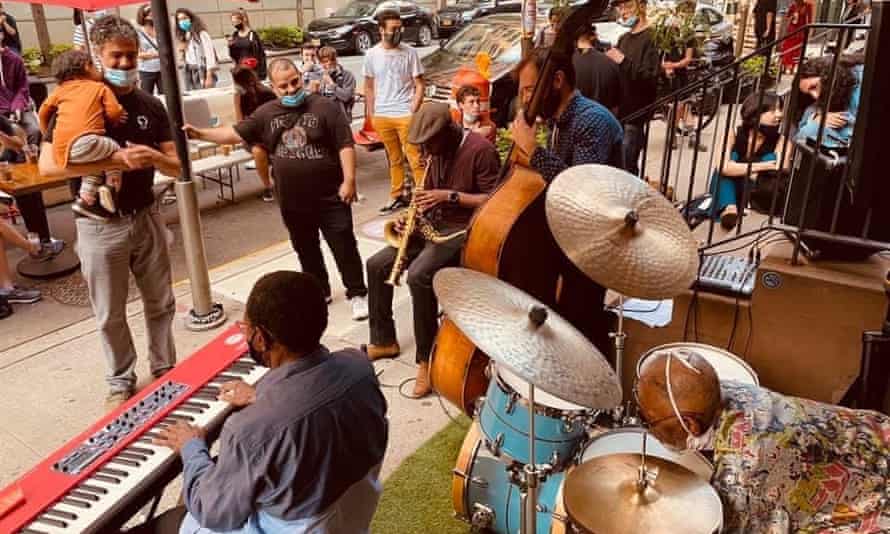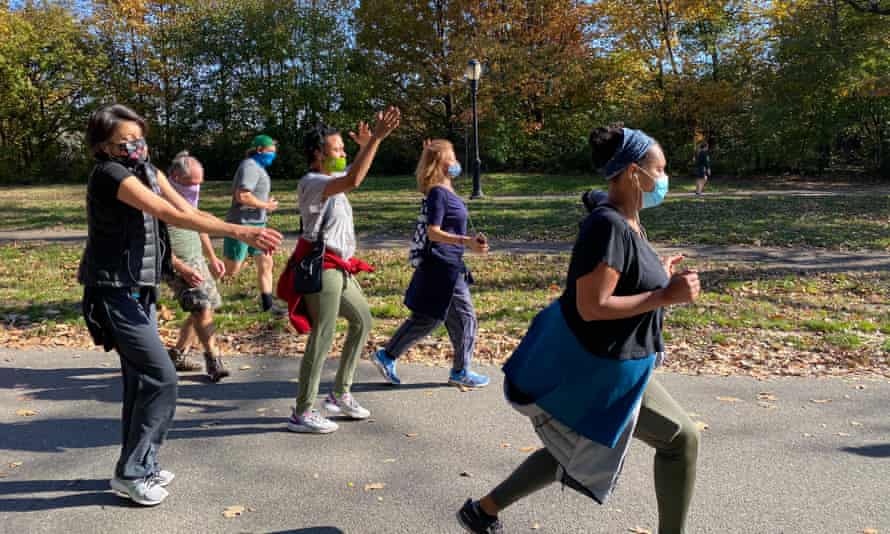Sign up for the Guardian Today US newsletter
Surrounded by snow and ice, against the backdrop of the Manhattan skyline and the East River, members of a dance troupe launched into their ballet exercises using a hand rail as a makeshift barre.
With coronavirus still very much a threat in New York, and the city’s theatres and performance venues closed and no return date yet set, some musicians, dancers and actors are going to extreme lengths to continue rehearsing, training and performing outdoors, despite the wintry conditions.
At the Phoebe Berglund Dance Troupe (PBDT) class this week, dressed in hats, boots, double coats, matching ballet skirts and embroidered face masks, the professional dancers braved freezing temperatures to train and rehearse new work on the Williamsburg waterfront in Brooklyn.
Pre-pandemic, they trained at Baryshnikov Arts Center in Hell’s Kitchen, Manhattan. But with the venue closed due to the coronavirus, the group has been training outdoors weekly since August – whatever the weather.
“The waves are crashing, it’s really beautiful,” said the choreographer and artist Phoebe Berglund, who wears seal skin trousers and a fur hat to stay warm. “The preparations for this weekly meeting are wild. I have to pay attention to the tides, the wind, the temperature, the moon cycles, all of it.”
Berglund, who was working on a piece for Sadler’s Wells theatre in London when the pandemic hit, said she spent the first few months of the pandemic in isolation working from her apartment, but found it difficult to connect with dancers on Zoom. For many of the group, the weekly rehearsals are their only social interaction.
“When there’s so much uncertainty in the world and with our futures, it means a lot to me and the dancers that we know that we’re going to meet, we know that we’re going to dance outside, we know that it will happen once a week.”

Berglund, who has held artist residencies at New York institutions including MoMA PS1 and Storm King, said with so many arts spaces closed or not doing live performances, it’s enormously challenging for performers.
“That’s why we’re like, ‘well, we don’t have any institutions, we have to make our own institution. So, what can we do to keep going?’”
They work towards seasonal performances, set to specially composed music by the musician Joseph Johnson. The choreography changes with the seasons to keep them moving when it is cold.
Johnson, 39, said he has seen a lot of outdoor community-based performances in Queens, by “people sick of being in their house, coming out and playing together”.
Performers, he added, are trying to find ways to adapt to the pandemic. “I haven’t really seen less culture, it’s just different.”
Despite the proliferation of livestreaming and remote online performances and a $15bn federal grant fund for closed venues across the country, the future of New York’s performance spaces remains uncertain.
Charlotte St Martin, the president of the Broadway League, said she hoped Broadway would be able to reopen in the autumn, but that it would “depend on the governor and the technology and the safety and security protocols that are available at that time”.
Until November, the jazz bassist Alexander Claffy was co-running an outdoor session at Terremoto Coffee in Chelsea. Through the winter he has continued to perform outdoors and in windows of restaurants as well as live streams including Keystone Korner in Baltimore and Smalls jazz club in New York.
“There are so many online resources, but when you are playing in that little window out to some people on the street, people really stop and listen and are really in the moment because everybody’s sick of staring at a 12in screen,” said Claffy, 28, who wears gloves and three pairs of socks to play outdoors.
During the summer, outdoor performances emerged all over New York – in parks, on streets, rooftops and people’s doorsteps. Almost a year into the pandemic, with the arrival of spring, outdoor performances are expected to boom.
Claffy said: “I have a feeling it’s going to be amazing and there’s going to be all sorts of music outside. And the joy that musicians are experiencing together right now when they’re playing, it’s unlike anything. The music just explodes, it’s incredible, because we’re used to playing every night and now we’re playing once a week if we’re lucky.”
Music and dance are also offering much-needed release to those who don’t do it for a living. Documentary editor and producer Joanne Nerenberg, 51, started Dance Walk, a weekly communal dance around Prospect Park in Brooklyn, in 2015. But since the pandemic it’s taken on new meaning.

“Moving with other bodies, it definitely feels different and people are so appreciative to have that experience which they feel like they’re so lacking right now,” she said.
Caitlin Grace McDonnell, 51, a writing teacher and poet who attends, said: “People are so isolated and dancing is such a great way to be with people.”
She added: “There’s been a real movement in Brooklyn for people performing music on their porches and people coming together to do that, or doing theatre.”
Among the initiatives aimed at “jumpstarting” New York’s live entertainment scene are NY PopsUp, a festival of hundreds of performances from 20 February to September, featuring artists including Q-Tip, Amy Schumer, Hugh Jackman, Billy Porter and Patti Smith. Governor Andrew Cuomo has proposed tax credits for New York City musical and theatrical productions. Meanwhile, Mayor Bill de Blasio last week announced Open Culture NYC, an initiative to allow ticketed performances on some city streets.
Ballet teacher Kat Wildish, 61, has been putting on weekly classes attended by both professionals, including Broadway stars, and recreational dancers in Central Park every Sunday since April. She even has a battery-powered piano for Sean Pallatroni, 33, who accompanies the class of about 20 pupils live.
Last week they met during a snowstorm. “It’s just beautiful with all the trees with the snow on the branches and it was beautiful also dancing in the open air … you can’t really point your feet in snow boots, but we try to make the best lines possible,” said Wildish.
The pandemic, she said, has been a huge adjustment for performers to keep up their training and continue to make a living, often through teaching.
“Unemployment doesn’t pay the rent in New York, so they have to find ways … we try to stay as positive as possible because there is a lot of depression in the field itself. That we have no theatres to go to, no studios to go to, very few studios.”
They often attract spectators during classes. Later this year, Wildish hopes to put on performances such as a section of Swan Lake outdoors. She hopes the pandemic will help to make culture more accessible.
“Everybody’s out of work and it’s necessary that we bring that art back into the city so that everybody knows that this is what we have here – that it hasn’t moved away, it’s not some place else, it’s here still,” she said.
This content first appear on the guardian
